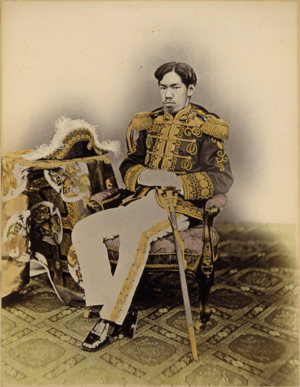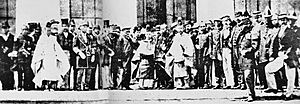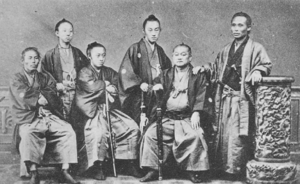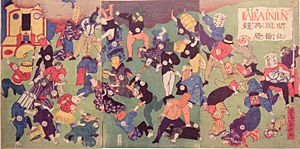Meiji Restoration facts for kids
Quick facts for kids Meiji Restoration |
|||||||
|---|---|---|---|---|---|---|---|
| Part of the end of Edo period and Boshin War | |||||||
 Emperor Meiji in 1873 |
|||||||
|
|||||||
| Belligerents | |||||||
| Commanders and leaders | |||||||
 |
|---|
|
The Meiji Restoration (明治維新 (Meiji Ishin)) was a major political event in Japan. It happened in 1868 and brought back the power of the Emperor of Japan. Before this, Japan was ruled by military leaders called shoguns. The Meiji Restoration gave the Emperor real control again.
This event caused huge changes in Japan's government and society. It marked the end of the Edo period and the start of the Meiji era. During this time, Japan quickly became a modern country. It adopted many ideas and technologies from Western countries.
Contents
Why Japan Changed: Foreign Influence
Japan realized it was behind Western countries in technology. This became clear in 1853 when US Commodore Matthew C. Perry arrived. He came with large warships that had much better weapons than Japan's. Perry wanted Japan to open its ports for trade.
Japanese leaders understood they needed to change. They believed Japan had to "throw open its doors to foreign technology." The Meiji Restoration leaders wanted to make Japan strong. Their goal was to protect Japan from being taken over by other countries.
This period ended Japan's long policy of sakoku. For about 250 years, Japan had been mostly closed off from the rest of the world. The word "Meiji" means "enlightened rule." The leaders wanted to mix "modern advances" with traditional "eastern" values. Key leaders included Itō Hirobumi, Kido Takayoshi, Ōkubo Toshimichi, and Yamagata Aritomo.
The Emperor's Return to Power
The Meiji Restoration began with an important agreement in 1866. This was the Satchō Alliance between the Satsuma and Chōshū regions. Their leaders, Saigō Takamori and Kido Takayoshi, wanted to reform Japan. They supported Emperor Kōmei, who was Emperor Meiji's father.
A man named Sakamoto Ryōma helped bring these leaders together. Their goal was to challenge the ruling Tokugawa shogunate and give power back to the Emperor. After Emperor Kōmei passed away in 1867, his son Meiji became the new Emperor. This time also saw Japan move from a feudal society to one with a market economy.
The End of the Tokugawa Shogunate

The Tokugawa government had ruled Japan since the 1600s. They created a strong system that controlled all the powerful lords, called daimyō. This system prevented any one daimyō from gaining too much power.
The Tokugawa shogunate officially ended on November 9, 1867. Tokugawa Yoshinobu, the last shōgun, gave up his power to the Emperor. This was called the "restoration" (Taisei Hōkan) of imperial rule. However, Yoshinobu still had some influence. On January 3, 1868, the young Emperor Meiji fully took away all of Yoshinobu's power. He formally declared that his own power was restored.
In 1869, the daimyō from Tosa, Hizen, Satsuma, and Chōshū regions gave their lands back to the Emperor. Other daimyō soon followed. This created a strong central government in Japan. The Emperor now had direct power over the entire country.
Some forces loyal to the old shogunate tried to fight back. They escaped to Hokkaidō and tried to create their own republic. But the Emperor's forces defeated them in May 1869. This battle marked the final end of the Tokugawa shogunate. The Emperor's power was now fully secure.
By 1872, all the daimyō were told to return their lands to the Emperor. The nearly 280 old domains became 72 prefectures. Each prefecture was controlled by a governor chosen by the state. The daimyō who cooperated were given important roles in the new Meiji government.
Modernizing the Military and Society
Emperor Meiji declared in 1868 that "Knowledge shall be sought all over the world." This was to make imperial rule stronger. A group of Japanese thinkers formed the Meiji Six Society in 1873. They wanted to promote modern ideas and ethics.
Political power shifted from the Tokugawa shogunate to a small group of leaders, called an oligarchy. Most of these leaders were from Satsuma and Chōshū regions. They believed the Emperor should be the spiritual leader. His ministers would govern the country in his name.
This new government worked to strengthen its power. They also aimed to get rid of the old class system. This system had divided society into four groups.

At the time, there were about 1.9 million samurai in Japan. Samurai were not just lords, but also their high-ranking followers. They received fixed payments, which was a huge cost for the government.
The government slowly worked to end the samurai class. In 1873, samurai payments began to be taxed. In 1874, samurai could turn their payments into government bonds. By 1876, this became mandatory.
To reform the military, the government started nationwide conscription in 1873. This meant every male had to serve four years in the armed forces. They then served three more years in the reserves. Before, only samurai had the right to carry weapons. Now, this right was given to all men. Samurai were also no longer allowed to carry swords in public to show their status.
These changes led to some samurai riots. The biggest was the Satsuma Rebellion, led by Saigō Takamori. However, the new Imperial Japanese Army quickly put down this rebellion. The new army was trained with Western tactics and weapons. This showed the samurai that their old way of life was truly over. Many samurai found new jobs in the government or as teachers and officers. The idea of the samurai spirit, however, lived on.
The government also made changes to land ownership. They made the system of renting land legal. This had been happening secretly during the Tokugawa period. Farmers had been leasing land and becoming rich. This disrupted the old class system and helped lead to the shogunate's downfall.
Japan's military grew strong with conscription and new training. Its success in wars like the First Sino-Japanese War made Japan feel like a rising world power.
Centralizing Japan
The government made big changes to Japan's social structure. They wanted to create a strong, unified country. They created a "standard language" (標準語 (hyōjungo)) based on the Tokyo samurai dialect. This new language replaced local dialects. It became the standard in schools, media, government, and business.
The Meiji Restoration also changed how Japan saw itself in Asia. Japan was the first Asian country to modernize like Western nations. This changed the old system where China was seen as the most powerful.
The Japanese government also started a national system of public schools. These free schools taught reading, writing, and math. Students also learned about their duty to the Emperor and the Japanese state. By the end of the Meiji period, most children attended public schools. This helped create many skilled workers. It also helped Japan's industries grow.
Opening up Japan meant more than just opening ports for trade. People from different societies began to mix. Western teachers and advisors came to Japan. Japanese people also traveled to Western countries for education. All of this helped Japanese people learn about Western customs, technology, and systems. Many believed Japan needed to adopt Western ideas to become a strong nation.
Industrial Growth
The Meiji Restoration sped up Japan's industrialization. This helped Japan become a military power by 1895. Their slogan was "Enrich the country, strengthen the military" (富国強兵 (fukoku kyōhei)).
During the Meiji period, countries like Europe and the United States helped Japan. Japanese leaders traveled abroad to learn about other governments and industries. They used this knowledge to improve Japan's own production. Japan also had few natural resources, which made it less attractive for Western countries to colonize. This helped Japan develop its own industries.
Japan's rapid industrialization needed a huge increase in production and infrastructure. Japan built new industries like shipyards, iron factories, and spinning mills. These were then sold to business owners. Japanese companies used Western technology to make goods that could be sold cheaply worldwide. Industrial areas grew quickly, and many people moved from the countryside to these new centers. Industrialization also led to the development of a national railway system and modern communication.
With industrialization, the demand for coal grew dramatically. Coal was needed for steamships and railroads.
Changes to Culture and Traditions
Many Japanese castles were destroyed in the late 1800s during the Meiji Restoration. The government wanted to modernize Japan and break from its feudal past. Today, most castles in Japan are new concrete copies built for tourists.
During the Meiji Restoration, many Japanese Buddhist statues and temples were destroyed. The government also tried to ban cremation, but this was unsuccessful. They later promoted cremation for health reasons.
The Meiji government also ended the traditional "untouchable" status of the burakumin class. This led to some revolts by samurai who were angry about the change.
In 1871, Emperor Meiji issued an order called the Dampatsurei Edict. This forced samurai men to cut their hair short. They had to give up their traditional chonmage (chonmage) hairstyle. This was part of the effort to modernize the appearance of upper-class Japanese men.
See also
 In Spanish: Restauración Meiji para niños
In Spanish: Restauración Meiji para niños



